
Chores for Little Family Members
In my house growing up, we did chores as a family every Saturday morning. I remember it so vividly. Ginny and I had to clean our rooms, change our bedsheets, and then we each had a list of chores to help with around the house that changed every week, as my mom needed. And my parents helped, too. No one could escape chores. And Chris’s family was the same way. I can remember being over at his house on the weekends during chore time, and his dad handing me a broom and laughingly telling me to get to work.
But he was serious.
Both of our families valued children contributing to the household. And as adults, and now parents, Chris and I are really grateful that they did. For one thing, it taught us how to take care of our house. We knew what basic chores needed to be done each week in order to keep things neat and clean (most of the time).
But, more importantly, it taught us each personal responsibility. It taught us to take pride in the things we owned, to take care of things we possessed, and to treat our home and our valuables with respect. It also taught us to take personal responsibility for being part of a family. We lived in those houses, too. There was no reason our parents should have been walking around cleaning up after us when we were more than capable.
For these reasons (and a few others we have discovered through trial and error in our own kids), we are big believers in chores for our children, which surprises people because Bean is five and Gracie is only three. But as my mother-in-law says, “If you are big enough to make the mess, then you are big enough to clean it up.”
We started chores with Michael when he was four years old. Well, I should clarify that. We started ASSIGNED chores when he was four. Both of our kids have had to clean up their messes since they were at least two, and even earlier with our help. But for daily, routine chores, we started at four. By four, Bean was able to really LEARN about responsibility. Nothing too deep. Just the idea that we have to help Mom and Dad and we have to do certain things because we are part of a family. We have ended up starting Gracie a little earlier simply because she asked! She loved Michael’s chore chart and she really wanted one of her own, so Grandmomma bought her one for Christmas and we have been using it for the past few weeks with great success.
Yes, chores can teach personal responsibility, but they can teach so much more! One of the lessons our kids have learned through chores is about working hard for a reward. We don’t do an allowance, and I’m not really sure we ever will do a traditional allowance. But we do definitely reward the kids for completing their chores. Some families I know choose NOT to have an award for chores because they feel that chores are simply what you should do and they don’t want their kids to learn to expect payment for things they should be doing anyway. I completely agree with this thought, as well. In fact, that’s how I was raised. I don’t think I ever got an allowance, and if I did, it certainly wasn’t tied to chores. I was just expected to do them. But Chris and I found this to be a teachable moment for our kids, and so we have tied a reward in with their chores.
Here’s how we work it:
The kids each have their own chore chart. I am a HUGE fan of this Melissa and Doug chore chart. It has a set of chores that you can change out and that work for a wide range of age groups, so it will grow as my kids grow. It also comes with two blank white magnets that we can write in our own chores on, if we wanted to customize something.
(This is a close up of all the chore options on the chart…)
The kids love it because it has the magnetic smiley faces for them to put up when they complete a chore. The magnets are supposed to stay on the bottom board and then the kids can move them up as they complete their chores, but we were having an issue with some “overly enthusiastic” chore doers, and so we put the smiley face magnets in a bowl that I keep on top of the fridge. Now, they have to SHOW me their chore before I give them the bowl to pick their magnet (the picking of the magnet is HUGE in our house).
The reward for our chores is three-parts. If the kids complete EVERY chore EVERY day of the week (which sounds like a lot, but their chores are pretty simple), then they get their reward on Saturday morning.
My mom gave them each these really neat coin banks called, “My Giving Bank,” for Christmas that divide their money into three parts – one for spending, one for saving, and one for giving. We have incorporated those banks into our chores now. So, if they kids complete their chores throughout the week, they get three dollars on Saturday. One to put in their savings, one of give to the offering plate in church on Sunday, and one to spend at the Dollar Store.
Then, later that morning when I go grocery shopping, I take them with me and we stop first at the Dollar Store. I like this store for them because NOTHING is off limits. I don’t have to regulate spending or prices or anything like that. They can choose ANYTHING they want from the store, and they love that. This week, Gracie picked a mermaid toy and Bean chose a ninja sword (which he then shoved into the back of his tee shirt for the rest of the day, like a Ninja Turtle).
I like giving them the chance to go spend their money because it teaches them even more. Now, they understand the value of working hard and being able to buy what they want with money they have earned themselves. It also has taught them about paying for their own items since they do the entire checkout themselves. They practice speaking to store clerks and using manners and waiting in line… all things that I think if we don’t INTENTIONALLY teach our children, are overlooked learning experiences.
I get asked about what chores we ask the kids to do. Generally speaking, Michael’s chores are more “chore-ish” than Gracie’s right now, simply because he is capable of more. Gracie’s chores are more likely to be things that we will do together in the course of a day, but making them “chores” gives her some responsibility to take on those tasks herself. For example, she refused to dress herself for months. I worried she would be in college and calling me asking about how to put on a pair of shorts. But I turned it into a “chore,” by telling her that she had to dress herself in order to get her smiley face. Now, she kicks me out of the room each day so she can dress herself.
We also try to put at least one behavioral chore on the chart each week, too. Usually, it’s what they are struggling with. Michael’s has been keeping his hands to himself and Gracie’s has been showing respect because those are the things each of them are working on. This gives us a chance to reward that behavior that we want to see so that we aren’t always just correcting the bad behavior. To earn their smiley face for behaviors, at dinner Chris and I decide if they have shown that behavior enough that day to get a smiley face. This doesn’t mean they have had a perfect day. It just means they were overall pretty good. We’re trying to build confidence with the chore chart, not use it as a punishment. We WANT them to earn their smiley faces, but we certainly aren’t giving them away without reason.
So, that’s how we do chores in our house right now, but what about in your family? I love hearing about how other families handle household obligations. Does your family use chores? Allowances? What do you ask of your children?
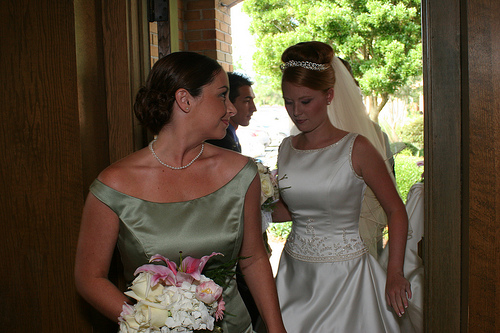


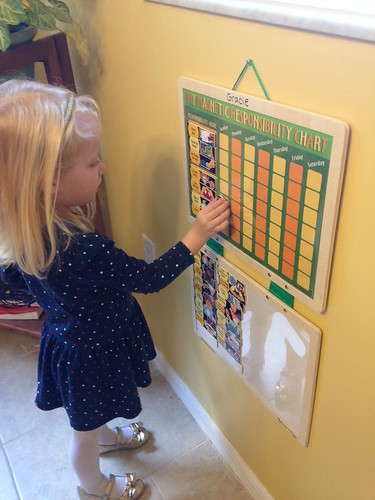
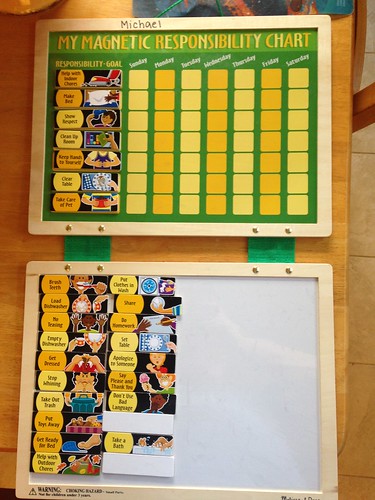

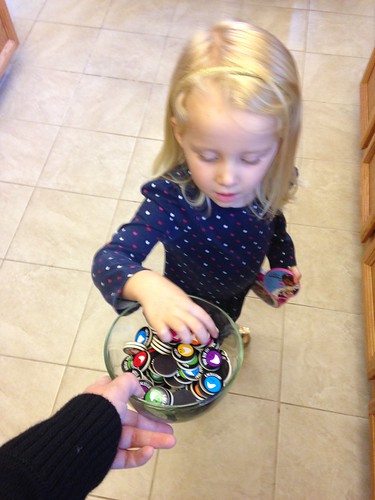



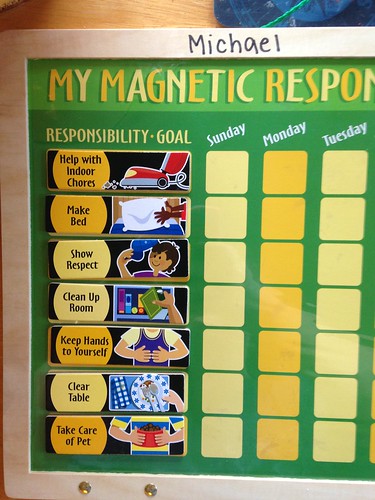

6 Comments
Erin
Love those charts! We use the Dave Ramsey Financial Peace Jr. with our 5-year old and she loves it! She gets 30 cents per chore and ten cents goes in each envelope: give, save, and spend. She has to practice ballet, take out the trash, and get the mail each day. We’ll add more as she gets older. She also has to help with a few things (making her bed, putting her dishes in the dishwasher, cleaning up her own toys) each day, and we don’t pay her for those. I was taught to be helpful and, like you, I think it’s important for our kids to help, too.
Barbara Manatee
We have tried several options for chore charts over the past few years. First we did one as a “responsibility chart” where each kid picked 3-5 chores for the week and we printed off a chart from the website http://www.goalforit.com/. We also included some ‘behavioral’ goals with that one so it wasn’t just ‘jobs.’ That worked for a while – they earned points and depending on how many points they earned, they could choose from a leveled system – more points were a bigger reward like “lunch out with mom or dad”, extra story with Mom or Dad, go for a treat with mom or dad, etc. We tried to get some ‘quality time’ rewards in there, not just tangible items. The system was kind of complicated though so we switched to a different system after a while and we’ve been using this one for a while now.
We brainstormed all the usual chores the kids could do around the house – set table, dry dishes, help with laundry (i.e fold socks, put away clothes, fold towels, etc), feed the dogs, take care of recycling or trash, make bed, pick up toys, etc. We have a weekly grid/chart and whoever volunteers for a chore, puts their initial on it. At the end of the week, they earn $ for each chore done. they get $0.05 per chore but if they do more than 20 chores/week, they earn double. Sometimes I feel bad for paying so little but it does add up a lot and the bonus is a big incentive to do more. It works GREAT for my 8 year old son, his twin sister is hot/cold with it (some weeks she does lots while other weeks she doesn’t care…and my 5 year old hasn’t been too motivated by it). But its the easiest system we’ve used.
The kids also have 3 banks for “Save, Share, Spend” so they work to divide up the money they earn.
Leslie
My boys have consistent “around the house” chores that they are responsible for. We do not give an allowance for them. We do have chore charts (canvas boards painted with “to do” and done” – and they have labeled clothespins with each chore on it) but we don’t use them much. I think because the kids are older, they already know what their assigned chores are, it’s probably not necessary anymore. It was when they were smaller though. They are now 10 and 5. The oldest has things like: clean the litter box, clean the toilet, scrub the shower, vacuum the living room, put away clothes, clean your room, wipe out the microwave, etc. The youngest has things like: feed the cat, match socks, put away clothes, clean your room, etc. They also have to help around the house with other chores as needed and especially have to help with cooking on occasion because I am determined to make sure they know how to cook.
Alanna
Such good timing – we have been talking about implementing something for our almost 4 year old, both chores and behavior things. I got an allowance, but it was not tied to chores. My parents didn’t want the situation to come up where I decided the allowance wasn’t worth doing the chores and said, thanks, but no thanks. 🙂 Like what you mention above.
Questions – does every chore have to be done 100% (whole week of smileys) to get the $3? Have you allowed them to save their $1s to get a bigger toy (not sure my little would understand that concept yet)?
Jen
Sullivan’s has been pretty informal so far but I love that chart. Might have to go on my Amazon wish list (with tons of other stuff). We tend to reward with fun activities instead of toys because he has so stinking many. So we’ll head to the zoo or the Magic House or ask him what he wants to do. It’s things we do anyway but he knows that they are special things and not done all the time.
Mandi
I ordered these same chore charts based on your post. I got one for each of my 3 little girls. They are a huge hit! I didn’t know anything like this was out there. I never checked, I had just assumed everyone used obscene amounts of paper and stickers. This works fantastically!! Thanks for the idea 🙂